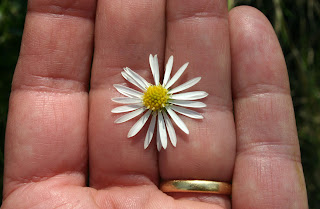Calotis cuneata
FAMILY: ASTERACEAE

The season is having a hard time getting out of its winter jacket this year - but we know it’s really spring when the daisies start coming out again.
After a slow start, the flowers are beginning to be seen in our local greasslands again.
We have tended to ignore our local daisies for garden use, yet there are a number of suitable species - modest little plants with considerable charm. Several of them, The Calotis species, area mixed blessing because each seedhead matures into a little prickly ball of seeds, which can break apart on contact, and leave seeds sticking in your socks.

The one pictured here is called "mountain" daisy, but this seems to be a bit of a misnomer, as it grows on the gently sloping blacksoil hillsides west of Toowoomba, as well as further out on dryer soil types, where the flowers tend to be purple.
The burrs can be a nuisance to those who tramp through patches of them in the wild.
Meanwhile, the rather large, fresh white daisies are plentifully produced over a long season, and could be a worthwhile addition to a garden. They grow to be knee-high, so are best at the back of a garden bed, partly to keep them behind smaller plants for a nice display, and partly to keep them away from paths where the burrs can annoy.
They grow easily from seed, and also spread (though not too vigorously) by underground stolons. Annoying plants can easily be cut back for fresh growth.
They are short-lived perennials, best replaced from seed every three or four years. They are quite likely to do this without any help from us, coming up as self-sown seedlings where conditions are right for them.
As with all our local daisies, they are very hardy to frost and drought, and will grow in full sunlight or dappled shade.

2 comments:
How anybody could recommend planting this in your garden is beyond me. Not only is this growing west of Toowoomba but also east in the Lockyer Valley. We have acres of it and I would really love it to be classed officially as a noxious weed. It is very prickly and the broken bits end up in your carpets and certainly don't wash out of your socks. Can someone please tell me what poison to use to get rid of our infestation?
Yes.
What was I thinking?
A rewrite is needed there.
Trish
Post a Comment